Energy – how secure is its future?
On our contested planet there are players (the decision makers – organisations, groups and individuals). All the players hold different opinions, values and perspectives. The response to any issue warrants an action. In geographical terms such actions are commercial and market led, perhaps focusing on national planning and are top-down in nature or are sustainable, often community led and bottom-up in nature. Based on the players and their actions our futures are decided. The routes taken are either ’radical’, where attempts are made to return the environment to how it was, or are ’sustainable’ where some stabilisation is attempted. Alternatively, they just focus on carrying on as we’ve always done, the so called ’business as usual’ route.
Energy supplied is either primary or secondary in nature. Energy could come directly from an oil fired source or it could secondarily heat water, producing steam and then turning turbines. The UK’s primary energy mix is shown below.
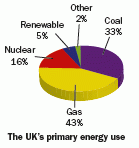

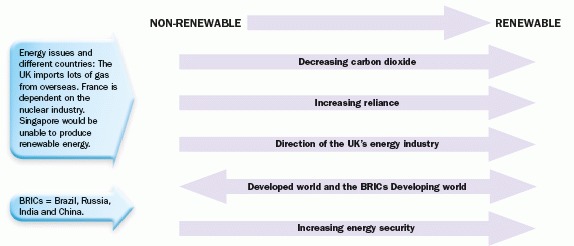
Global energy distributions
Some countries produce lots of energy, while others produce very little energy. Production is relative to the amount of resource available and the money to exploit it!
See below for known examples of countries with high and low energy consumption and how their needs are supplied.
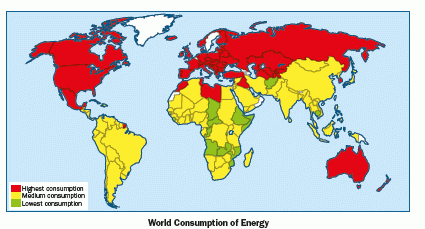
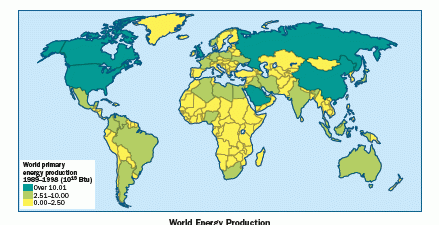
There is a very strong link between gross domestic product (GDP) and energy consumption. The rich countries generally use more energy than poor countries.
Problems with fossils fuels
Many pollution issues have been identified relating to fossil fuels.
- Acid rain: Burning fossil fuels releases gases that make precipitation acidic.
- Oil spillage: Causes environmental damage.
- Global warming: Fossil fuels burned during energy production release carbon dioxide – this is a greenhouse gas which is linked to climate change.
- Mining: Open cast mining destroys huge areas of land.
The politicisation of energy
Shortages of energy resources ensure that energy resourcing and production is top of many countries’ agendas.
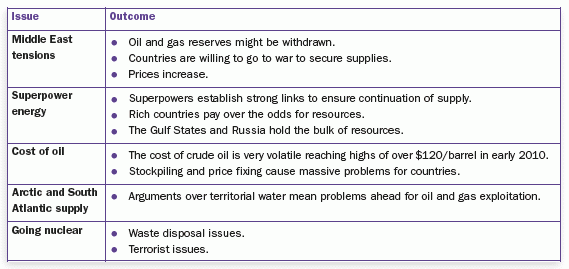
Alternative and sustainable energy sources
With fossil fuel resources being depleted at an increasing rate, many countries have looked to other methods of energy production.
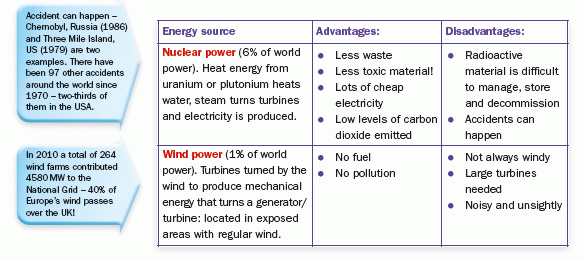
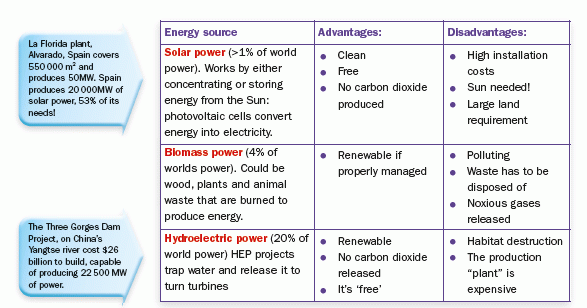
Other sustainable sources are wave and tidal power – both rely on expensive and largely unreliable equipment. They are both at the mercy of the elements. A potential advantage of wave and tidal power is that there is a seemingly limitless potential supply of energy from the sea and tides.
Case study: Two different biomass power plants, UK
Sembcorp Biomass Station is a £60 million biomass plant built in the Tees Valley, UK. It uses sustainably cropped wood to produce 30 MW of electricity.
Thetford Biomass Power Station is a £69 million biomass plant built in Norfolk. It is the largest power station of its type in the UK. Burning poultry litter it produces 385 MW of electricity. The by-product of burning is a high quality fertiliser which is used locally.
Case study: Energy targets and harnessing the waves
The UK could generate all the electricity it needed from around its long coastline. However, there are enormous hurdles to overcome, not least being able to construct a viable generator. By the end of 2010, 10% of electricity provided by the electricity supplier must come from such sources. It is thought that this requirement will help many rural communities to initiate and run their own renewable power plants.
Islay in the Inner Hebrides may be one of the first communities to benefit as they now have what is believed to be the world’s first commercial wavepowered generator. Part of the reason for the 10% renewable energy requirement is bound up in the government’s pledge in its report Energy – the changing climate, that is by 2010 carbon dioxide levels will be cut by 20%. The government offered four ways in which these
targets could be reached. The UK is embarking on a pathway that leads to a sustainable energy policy that protects the interests of future generations.
Recklessly causing large-scale disruption to the climate by burning fossil fuels will affect all countries. It is the poorest countries that would suffer most. The government recognised the value of nuclear power in providing carbon-free energy, but did not believe it was indispensable. The report confirms that fossil fuel economies, such as the UK’s, are on the wrong path, but it also shows that wind and solar power can break our addiction to oil, coal and gas. It makes clear that tinkering around the edges, which is what all governments are doing now, won’t stop climate change.
Future challenges for energy
For the future there will be a need to reduce our fossil fuel dependency as it becomes expensive and output drops. Fossil fuels also contribute to gas emissions and their contribution to global warming is well documented, as is governmental commitment to their reduction. So how will we cope?
- Through generating energy for ourselves – ground source, or local wind and solar power.
- By encouraging renewable energy – offering a greener future.
- Energy production must come from a mix of sources to ensure stability.
- Those that use the dirty fossil fuels must be heavily taxed – green taxes. The receipts from these taxes will pay for alternative energy sources.
